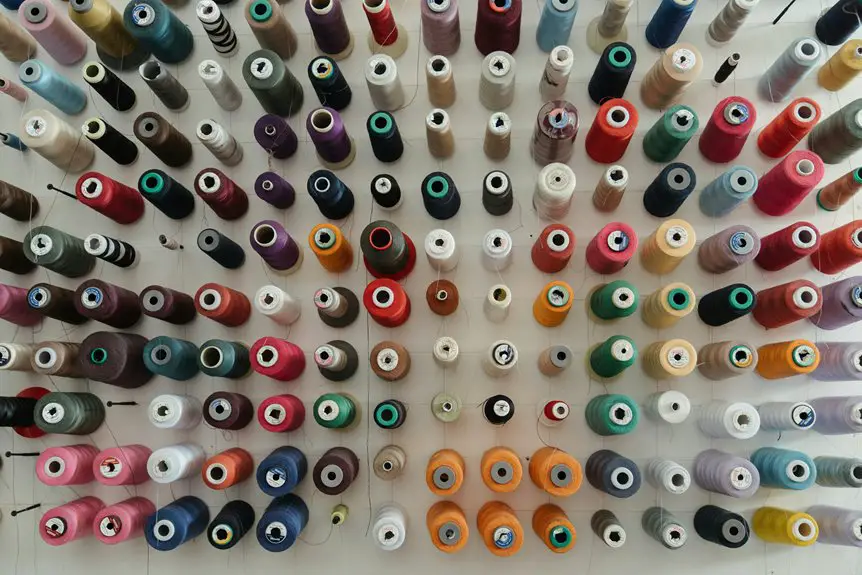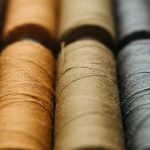If you want lightweight, moisture-wicking fabric that stays dry and handles tough wear, 100% polypropylene outperforms polyester. It’s more durable, resists mildew, and keeps sweat off your skin better, making it great for active or outdoor use. Polyester, though, offers better breathability and maintains color well, ideal for everyday wear. Each suits different needs, so your choice depends on how you plan to use it. Exploring their care and environmental impacts can help you decide best.
Table of Contents
Key Takeaways
- Polypropylene excels in moisture-wicking and quick drying, making it better for intense activities and wet conditions than polyester.
- Polyester offers greater breathability and better air circulation, enhancing comfort in everyday wear compared to polypropylene.
- Polypropylene is more durable and resistant to chemicals, abrasion, and shape loss, ideal for harsh environments over polyester.
- Polyester tolerates higher washing temperatures and bleach, providing easier care and maintenance than polypropylene.
- Environmentally, polypropylene uses less production energy and is easier to recycle, but both fabrics contribute to microplastic pollution.
Understanding Polypropylene Fabric: Characteristics and Uses
Polypropylene fabric stands out for its lightweight and moisture-wicking properties, making it ideal for activewear and outdoor gear.
Lightweight and moisture-wicking, polypropylene fabric is perfect for activewear and outdoor gear.
When you wear polypropylene, it keeps sweat away from your skin, helping you stay dry during intense activities. It’s also resistant to chemicals and doesn’t absorb water, so it dries quickly and stays comfortable.
You’ll notice it’s quite durable, handling wear and tear without losing shape. Since it’s resistant to mildew and stains, you can trust it for outdoor use or in damp conditions.
However, polypropylene isn’t as heat-resistant as some fabrics, so you’ll want to avoid high-temperature washing or ironing.
Key Features of Polyester Fabric
Durability defines polyester fabric, making it a popular choice for everything from clothing to home furnishings. When you choose polyester, you get a fabric that resists wrinkles, shrinking, and stretching, so your items keep their shape and look fresh longer.
Polyester also dries quickly, which is perfect if you need low-maintenance gear or activewear. It’s colorfast, meaning it holds dye well, so vibrant colors won’t fade easily even after repeated washing. Additionally, polyester resists mildew and most chemicals, making it practical for various environments.
You’ll appreciate its smooth texture and lightweight feel, which adds to your comfort. Overall, polyester offers versatility and ease of care, making it a reliable fabric option for many everyday uses.
Durability and Strength Comparison
When you’re choosing between fabrics, understanding how they hold up under stress can make all the difference.
Polypropylene is known for its impressive tensile strength and resistance to abrasion, so it handles rough use without tearing easily. It’s also less likely to degrade when exposed to chemicals or moisture, which adds to its long-lasting durability.
Polypropylene stands out for its strong tensile strength and excellent resistance to abrasion, chemicals, and moisture.
Polyester, meanwhile, offers excellent strength and resilience, but it can wear down faster with constant friction or heavy loads.
Both fabrics resist stretching and shrinking, but polypropylene tends to maintain its shape better over time.
If you want a fabric that stays tough in harsh conditions, polypropylene might be your pick; however, polyester still provides solid strength for everyday wear and tear.
Your choice depends on how demanding your use will be.
Moisture-Wicking and Breathability Performance
If you spend a lot of time outdoors or working out, moisture-wicking and breathability become essential factors in choosing the right fabric.
Polypropylene excels at moisture-wicking because it repels water and moves sweat away from your skin quickly, keeping you dry during intense activities. Its hydrophobic nature prevents it from absorbing moisture, which helps maintain lightweight comfort.
Polyester also wicks moisture but tends to hold onto some sweat, making it less efficient in very sweaty conditions. When it comes to breathability, polyester generally allows better air circulation, helping you stay cool.
Polypropylene, while moisture-wicking, can trap heat due to its tighter weave. Depending on your activity and environment, you might prefer polypropylene for dryness or polyester for better ventilation.
Comfort and Feel on the Skin
While moisture management plays a big role in keeping you comfortable, how a fabric feels against your skin can make just as much difference.
Polypropylene tends to feel lightweight and smooth, almost silky, which can be very pleasant for activewear or layering. It’s less likely to cause irritation or itchiness, making it a good choice if you have sensitive skin.
Polyester, on the other hand, can feel a bit heavier and sometimes less soft, especially in lower-quality versions. However, advances in polyester processing have improved its texture, so it can feel quite soft and breathable too.
Ultimately, you’ll want to take into account how each fabric interacts with your skin during wear because comfort isn’t just about temperature—it’s about the tactile experience every time you move.
Care, Maintenance, and Longevity
You’ll want to know the best cleaning techniques to keep polypropylene and polyester looking their best.
Understanding what affects their durability helps you make smart choices for long-lasting use.
Let’s explore how these fabrics hold up over time and what you can do to extend their lifespan.
Cleaning Techniques
Because polypropylene and polyester fabrics have distinct properties, their cleaning techniques differ to maintain durability and appearance.
When cleaning polypropylene, you should avoid high heat since this fabric melts easily. Use cold or warm water with mild detergent, and opt for gentle machine cycles or hand washing. Avoid bleach and fabric softeners, as they can degrade polypropylene fibers.
Polyester, on the other hand, tolerates warmer water and can handle standard detergents and bleach in moderation. You can machine wash polyester on regular cycles and dry it at low to medium heat settings.
Both fabrics benefit from air drying to preserve their shape and integrity over time. By tailoring your cleaning methods to each fabric, you’ll keep them looking fresh and lasting longer.
Durability Factors
Although polypropylene and polyester each offer strong durability, their care and maintenance play an essential role in how long they last.
You’ll want to avoid exposing polypropylene to high heat since it can melt or warp under intense temperatures. Polyester handles heat better but still benefits from gentle washing and air drying.
Both fabrics resist stains and moisture, making them easier to clean, but you should steer clear of harsh chemicals that might weaken fibers over time.
Regularly removing dirt and debris helps prevent abrasion that wears fabric down. Storing items in a cool, dry place also preserves their integrity.
Fabric Lifespan
Proper care directly impacts how long your polypropylene or polyester fabrics will last. Both materials are resilient, but you can extend their lifespan considerably by maintaining them correctly.
For instance, polypropylene resists stains and moisture well, yet harsh chemicals can degrade it. Polyester holds up against wrinkles and shrinking but benefits from gentle washing.
To keep your fabrics in top shape, consider these tips:
- Wash in cold water to prevent damage and color fading
- Use mild detergents without bleach
- Avoid high heat when drying; air-dry if possible
- Store fabrics away from direct sunlight to prevent weakening
- Regularly clean to remove dirt that can wear fibers over time
With these practices, you’ll enjoy your fabrics longer, no matter which you choose.
Environmental Impact and Sustainability Considerations
When you choose between polypropylene and polyester fabrics, you should consider their environmental footprints, including how each breaks down and how much energy is used in production.
You’ll also want to think about recycling options and waste management challenges for both materials. Understanding these factors helps you make a more sustainable choice.
Biodegradability Differences
Since you care about the environment, understanding how polypropylene and polyester fabrics break down is essential. Both are synthetic materials derived from petroleum, making them resistant to natural degradation processes.
Here’s what you should know:
- Polypropylene tends to degrade slightly faster than polyester but still takes decades to break down fully.
- Neither fabric is biodegradable in a typical composting environment.
- Both release microplastics as they wear, contributing to pollution.
- Recycling options exist but are limited and not widely accessible.
- Proper disposal and reducing use are key to minimizing environmental harm.
Knowing these biodegradability differences helps you make informed choices, especially if you prioritize sustainability in your fabric selection.
Energy Consumption Comparison
Although both polypropylene and polyester fabrics come from petroleum, they differ markedly in the energy required for their production.
When you look at energy consumption, polypropylene generally demands less energy to produce than polyester. This lower energy use comes from its simpler polymer structure and more efficient manufacturing process.
If you’re aiming to reduce your environmental footprint, choosing polypropylene can help since less energy means fewer greenhouse gas emissions during production.
However, polyester’s energy consumption isn’t drastically higher, and it benefits from well-established production technologies that continue to improve energy efficiency.
Ultimately, understanding these differences allows you to make a more informed choice based on how much energy input matters to you in the sustainability equation of your fabric selection.
Recycling and Waste Management
Recycling plays an essential role in managing the environmental impact of polypropylene and polyester fabrics. When you recycle these materials, you help reduce waste and conserve resources.
Both fabrics can be recycled, but the process varies in complexity and availability. Polypropylene often has fewer additives, making it easier to recycle, while polyester’s widespread use means more recycling programs exist for it.
To manage waste effectively, consider these points:
- Separate fabrics properly before recycling
- Check local recycling facilities for accepted materials
- Support products made from recycled fibers
- Avoid mixing fabrics in disposal to improve recycling quality
- Donate or repurpose old garments to extend their life
Frequently Asked Questions
Can Polypropylene Fabric Be Recycled Easily Compared to Polyester?
You’ll find polypropylene fabric easier to recycle than polyester because it melts at a lower temperature and has fewer additives. So, when sorting materials, polypropylene often goes through simpler recycling processes, making your effort more effective.
Is Polypropylene Fabric Hypoallergenic Versus Polyester?
They say, “Prevention is better than cure.” You’ll find polypropylene fabric generally more hypoallergenic than polyester since it resists moisture and bacteria better, reducing allergy triggers and keeping your skin happier and healthier.
How Do Polypropylene and Polyester Fabrics Perform in UV Resistance?
You’ll find polypropylene offers better UV resistance than polyester, making it less prone to fading and degradation under sunlight. So, if UV protection matters, choosing polypropylene helps your fabric last longer outdoors.
Are There Significant Cost Differences Between Polypropylene and Polyester Fabrics?
You’ll find polypropylene usually costs less than polyester, making it budget-friendly. However, prices vary by quality and supplier. Don’t forget to weigh durability and performance alongside cost before deciding what suits your needs best.
Can Polypropylene Fabric Be Dyed as Easily as Polyester?
You might think polypropylene’s hard to dye, but it’s actually trickier than polyester. Polypropylene resists most dyes, so you’ll need special methods or pigments, while polyester easily absorbs dyes with standard techniques.
- Tetron Fabric for Marine Applications: Durability and Use Cases - June 18, 2025
- Tetron Fabric for Outdoor Furniture: Weather Resistance and Care - June 18, 2025
- Tetron Fabric for Wall Coverings: Style and Application Tips - June 18, 2025







